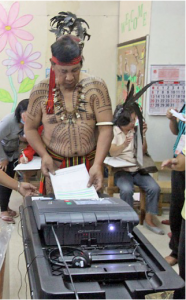September 8 is UNESCO’s International Literacy Day. One overlooked aspect of literacy limitations is its impact on voting.
Those who cannot read or who only read in non-majority languages are often disenfranchised from election processes that cater only to those who read and write the majority language of a country. Fortunately, new voting technology is helping to alleviate this problem and make elections more inclusive.

Literacy rates worldwide have continually risen in recent history. The global literacy rate for people over age 15 is 86.3%. Moreover, the average literacy rate across developed nations is 99.2%. Unfortunately, there are still 750 million illiterate adults around the world, two-thirds of whom are women. According to UNESCO (2018), “literacy challenges persist, distributed unevenly across countries and populations. Embracing linguistic diversity is central to addressing these challenges and achieving sustainable development.”
UNESCO’s 2019 theme, Literacy and Multilingualism, dovetails nicely with the celebration of the International Year of Indigenous Languages. Today’s election technology can support the participation of multicultural communities in the election process.
Why is it relevant?
People mostly understand literacy as a function of education. But it goes beyond reading and writing. The International Literacy Association (ILA) defines it as the ability to identify, understand, interpret, create, compute, and communicate using visual, audible and digital materials across disciplines and in any context.
Similarly, enabling multilingual options in digital democracies is closely linked to the progress of inclusive societies.
Here there are five ways in which election management systems and electronic voting support literacy and multilingualism during the voting process.
- Election systems designers and developers are leveraging machine learning and other AI technologies to make voting more accessible to voters with differing language needs such as indigenous communities or illiterate electors.
- Electronic voting systems offer a human-centered voting experience including multilingual interfaces on a single device and secure and convenient options for everyone, regardless of their (digital) literacy rate.
- Election technologies−including e-voting−have successfully reduced barriers to participation in countries with significant aboriginal communities, such as Canada, Australia, the Philippines, Brazil, Chile, and Ecuador.
- Technology can support election management bodies meet the challenges of “decoding digital literacy,” helping voters understand and apply digital information during voting.
- The election technology industry has recognized the value of supporting STEM education and basic computer coding, particularly for girls. Doing so supports the development of a diverse future workforce.